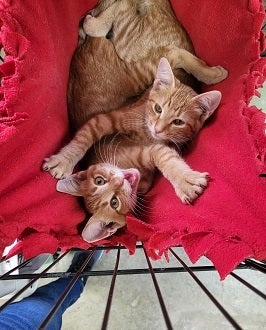
Are spay/neuter requirements saving lives or standing in the way of lifesaving?
June 14, 2023
We all know spay/neuter is the key to humanely managing populations of animals and that the best place for a pet is in a loving home. What does it mean, then, when those principles are at odds and adopted animals remain in shelters waiting for an opening in severely backlogged surgery schedules? When does a lifesaving tool like spay/neuter become a barrier to saving lives?
We discussed the current challenges around sterilizing pets in our January 2022 editorial, “The paradox of adopting out unaltered animals.” In that piece, senior director of lifesaving centers Sue Cosby noted it’s important to consider flexibility around spay/neuter policies not just now, “when greatly reduced access to veterinary services is backlogging surgeries, but because we’re always resource constrained and need to approach lifesaving challenges with a nuanced balance.”
Suggesting we rely upon the public to spay or neuter their adopted pets was met with a sense of confusion and frustration when Sue talked about it a year and a half ago. And the suggestion continues to be met with some serious concern, as we have seen following the recent announcement from PetSmart Charities. Beginning in July and running through at least the end of 2023, PetSmart Charities will no longer require puppies and kittens under six months of age be altered before coming into their stores for adoption events, or as a condition of being housed in PetSmart Adoption Centers. PetSmart Charities’ adoption partners are still responsible for ensuring post-adoption sterilization following applicable local, state, and provincial laws, but the change in policy hopefully will hasten the flow of animals from rescue groups and shelters and into homes—where we all agree they belong.
PetSmart Charities president Aimee Gilbreath explains the recent decision by saying, “We adapt where change is needed, and this one is urgently needed to save pets’ lives.” We couldn’t agree more. In fact, PetSmart Charities’ rationale echoes the argument that Sue made in her editorial: holding onto adopted cats and dogs until they can be sterilized is having significant, life-threatening repercussions. If there is anything worth being frustrated about, it would be an industry that is more accepting of such repercussions than one which is willing to adjust policies to meet the current needs in lifesaving.
Why should cats and dogs be losing their lives simply because they aren’t sterilized? While spay/neuter resources are stretched to an extreme degree, the public has a luxury that rescues and shelters often don’t: time. Private pet owners can wait the weeks it may take to get a surgery appointment, and those cats or dogs get to spend that time in homes instead of kennels. Isn’t that what we’re all working for?
Re-calculating risk in the face of fewer resources
 Adopted animals who stay in the shelter for weeks or even months waiting for a surgery slot are at risk of developing health and/or behavior problems that may jeopardize their adoption status, if not their very lives. They also take up valuable space and resources that are then unavailable to new arrivals. Even organizations that stopped euthanizing for space a long time ago may find themselves facing such choices again when intake numbers outpace the number of animals leaving with their new families. There’s also no guarantee the only animals losing their lives are the “less adoptable” ones. Senior dogs, playful kittens, lost pets waiting for their people to reclaim them—virtually any resident animal not already adopted is at risk when the overriding imperative is an urgent need for space.
Adopted animals who stay in the shelter for weeks or even months waiting for a surgery slot are at risk of developing health and/or behavior problems that may jeopardize their adoption status, if not their very lives. They also take up valuable space and resources that are then unavailable to new arrivals. Even organizations that stopped euthanizing for space a long time ago may find themselves facing such choices again when intake numbers outpace the number of animals leaving with their new families. There’s also no guarantee the only animals losing their lives are the “less adoptable” ones. Senior dogs, playful kittens, lost pets waiting for their people to reclaim them—virtually any resident animal not already adopted is at risk when the overriding imperative is an urgent need for space.
There are impacts beyond those on the animals, too. Staff at every level suffer physical and emotional stress caring for animals who should have gone home with their new families, and deciding which pet must give up their life to open a kennel space is not something we should ever ask of our employees—or ourselves.
Rescue organizations that hang onto adopted pets until they can be sterilized don’t face the same immediate repercussions because they aren’t compelled to accept relinquished pets like municipal shelters are. That doesn’t mean animal lives aren’t at risk somewhere, however. In a country where 378,000 dogs and cats lost their lives in shelters last year (up from 321,000 in 2021), a sense of urgency should underpin the policies and practices of every animal welfare organization, regardless of its status as a public or private entity.
Gaining perspective on roles, responsibilities
One of the loudest arguments against releasing intact animals is the belief that the public can’t be trusted to get their pets spayed or neutered. PetSmart Charities’ announcement is generating the same assertions that our editorial did: Releasing intact cats and dogs will only drive future intake and is antithetical to the goals of animal welfare. Such claims are not without merit. Many of us have experience with “frequent fliers,” individuals who seek out the help of shelters and rescues every year with litters of kittens and puppies because they did not have their pets spayed and neutered. But are these cases the majority? Probably not. According to the American Pet Products Association’s 2023–2024 National Pet Owners Survey, 86.9 million households own a pet, and Best Friends 2023 Brand Awareness Study found that 82% of all cats and 74% of all dogs in homes are spayed or neutered. If most people with pets allowed their animals to reproduce (or even have a “whoops” litter), U.S. shelters would be handling far more than the 4.4 million cats and dogs they did in 2022.
These figures also bring up a striking point about the role of rescue organizations and shelters in managing the size of the pet population. Clearly, our industry touches only a mere fraction of cats and dogs, and we struggle to get even those sterilized. As Sue pointed out in that 2022 editorial, when she was CEO of Animal Care and Control Team of Philadelphia some back-of-the-envelope calculations about the city’s community cat numbers led her to an astonishing realization:
Adjusting expectations about animal agencies
 Trusting the public can be tough, especially after seeing animal cruelty or neglect. But being at odds with the public doesn’t change the reality that our industry does not have the resources to ensure every single cat and dog in this country will be safe, healthy, and loved—nor are we the only ones who believe every animal deserves such things. The public is not incidental to our work as animal welfare professionals; they are an intrinsic part of it.
Trusting the public can be tough, especially after seeing animal cruelty or neglect. But being at odds with the public doesn’t change the reality that our industry does not have the resources to ensure every single cat and dog in this country will be safe, healthy, and loved—nor are we the only ones who believe every animal deserves such things. The public is not incidental to our work as animal welfare professionals; they are an intrinsic part of it.
Enlisting adopters in getting their new pets spayed or neutered is one way to begin changing the adopter/adoption agency dynamic. By capitalizing on a “try-before-you-buy model,” foster-to-adopt programs have been successful at moving animals out of shelters quickly and changing the expectations of each party. For instance, shelters may provide the first vaccine or dose of deworming but require the foster family to bring back the animal for subsequent doses. Specialized foster programs such as those for cats with ringworm are successful too, showing the lengths the public is willing to go in terms of providing care—whether they end up adopting that animal or not.
It’s not much of a stretch to include spay/neuter in this recalibration of roles, and there are many ways to go about increasing the odds that adopters will comply. A deposit can be exchanged for getting the spay/neuter procedure done at the shelter’s vet clinic or reimbursed upon proof of sterilization elsewhere. While some may argue they don’t have staff available to follow-up on administrative tasks like these, consider how much staff time is currently being used on daily care, medicating, or assisting with surgeries for those same animals. Odds are there are ways to shift what staff is spending time on, especially if it moves the needle for the animals in our care.
Embracing change is a choice
As drastic as PetSmart Charities’ latest announcement may seem to some, deferring sterilization is a deliberate tactic with the potential to change animal sheltering in a dramatic and positive way. That’s not just wishful thinking, either. Rather than simply waiving the spay/neuter requirement permanently and hoping for the best, PetSmart Charities piloted the concept first with a select few partners. The results? Some 98% of adopters followed up by getting their new pet spayed or neutered on their own. If we can trust adopters to get their new kittens and puppies sterilized, shouldn’t we also be exploring deferring spay/neuter for adult pets?
Of course, organizations don’t have to change their policies and practices at all. Those groups who want to continue bringing only sterilized animals to adoption events at PetSmart stores are absolutely encouraged to do so. PetSmart Charities’ policy is meant to give breathing room to those organizations that need it because they are struggling with the limited availability of spay/neuter resources, not to mandate the adoption of unaltered animals.
Requiring that every animal going into the community be spayed or neutered is still the ideal. But it shouldn’t become a direct cause of other animals losing their lives. If we don’t trust people to care for the animals who are, after all, their pets, we will never reach our goal of getting every adoptable cat or dog out of the shelter system and into a loving home. Without risk, there is no reward. The animals crossing our doorway every day are counting on us to keep taking calculated risks. Their lives depend on it.
The Association for Animal Welfare Advancement roundtable “Bottlenecks in Sheltering - Can Deferring Spay/Neuter Save More Lives?” provides further context for PetSmart Charities’ decision and addresses some of the most common concerns.

Brent Toellner
Senior director of lifesaving programs
Best Friends Animal Society
If you enjoyed this editorial, you can find our complete catalog of editorials here.